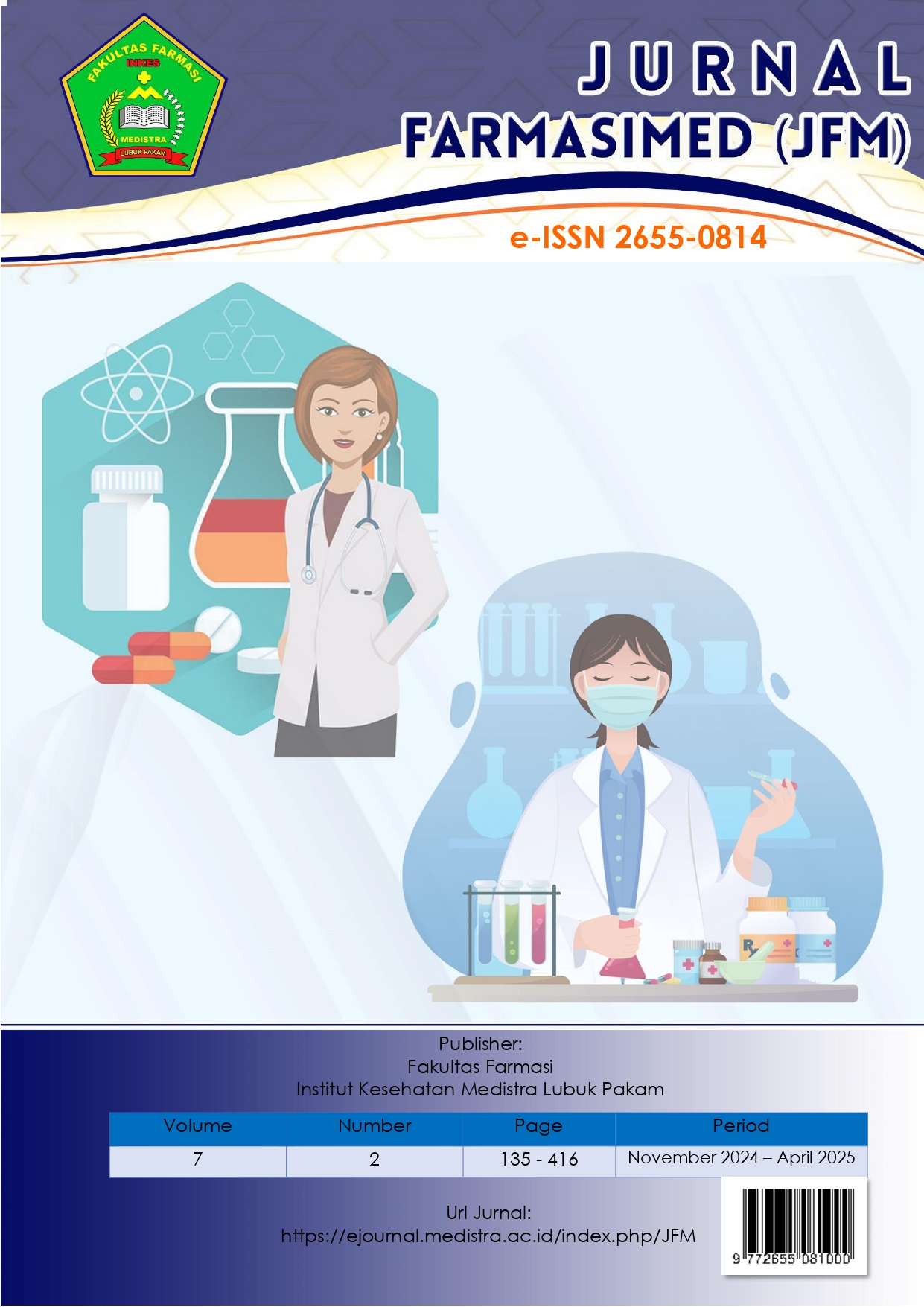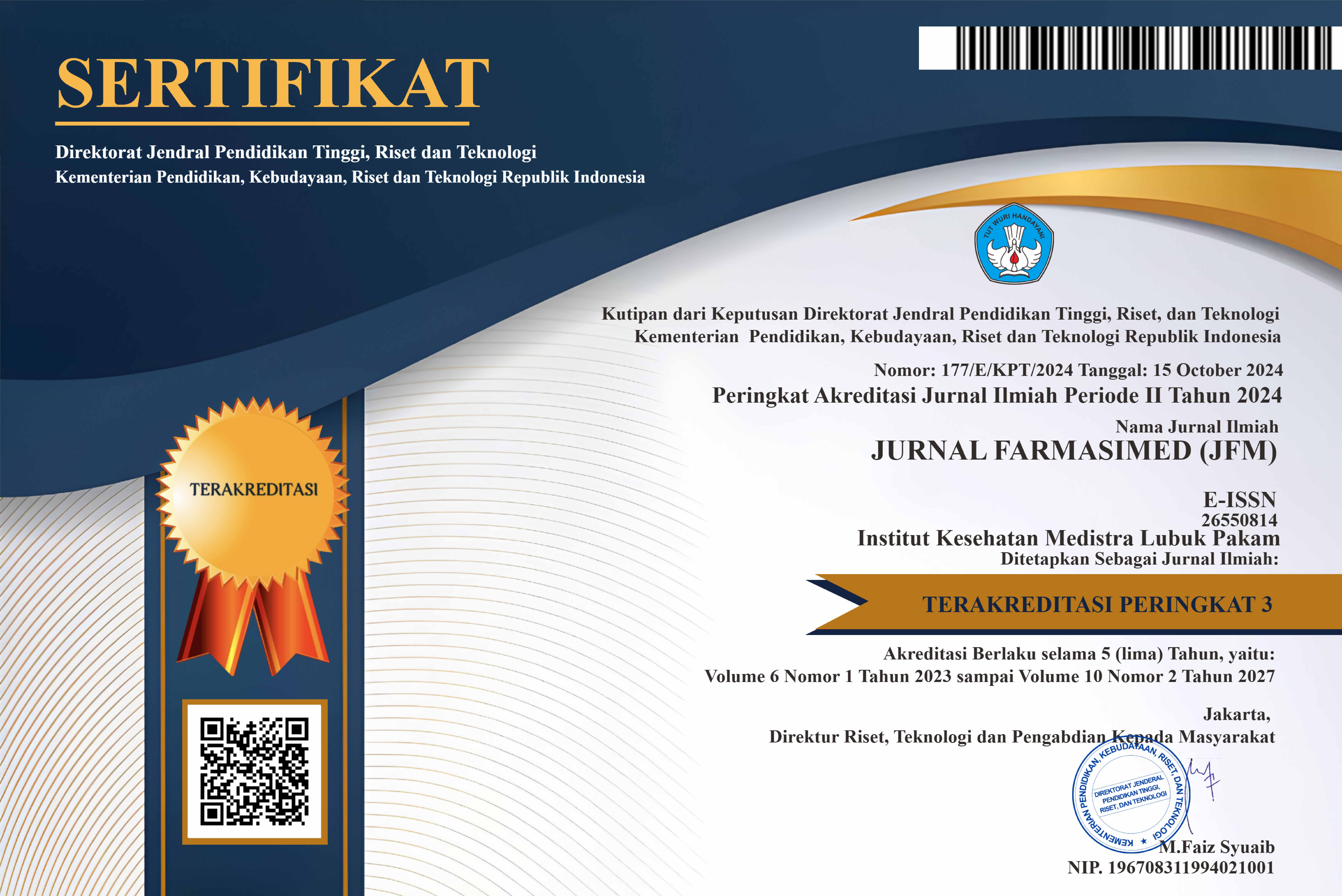Evaluation of Fondaparinux Use on Kidney Function in Hospitalized COVID-19 Patients with Decreased eGFR
DOI:
https://doi.org/10.35451/jfm.v7i2.2731Keywords:
Fondaparinux, Covid-19, Kidney Function, eGFR, AnticoagulantAbstract
Background: The COVID-19 pandemic has resulted in increased hospitalization rates among patients with multisystem complications, including coagulation disorders and decreased renal function. Fondaparinux, a synthetic anticoagulant with a lower risk of thrombocytopenia, is often used as an alternative to heparin. However, its use in patients with reduced glomerular filtration rate (eGFR) remains debatable, as its elimination is dependent on renal function. Objective: This study aims to evaluate the impact of fondaparinux on renal function, specifically examining changes in eGFR and serum creatinine levels in COVID-19 patients with impaired renal function during treatment at Bhayangkara South Surabaya Hospital. Methods: This research employed a retrospective observational quantitative approach, involving COVID-19 patients who received fondaparinux at the inpatient facility of Bhayangkara Hospital from June 2020 to October 2021. Data were collected from the medical records of patients during their hospitalization, including fondaparinux dosage and eGFR and serum creatinine values, as well as other relevant clinical parameters. Statistical analysis using the Wilcoxon test was conducted to assess significant differences in serum creatinine and eGFR values following fondaparinux administration. Results: Of the 535 patients analyzed, 56 medical records met the inclusion criteria. The results of the Wilcoxon test analysis showed that there was a significant increase in eGFR (p-value 0.012, CI 95%; p-value 0.043, CI 95%; p-value 0.000, CI 95%), a substantial decrease in SCr (p-value 0.035, CI 95%; p-value 0.043, CI 95%; p-value 0.000, CI 95%) based on each degree of COVID-19 severity. Conclusion: The use of fondaparinux may improve kidney function, as indicated by significant decrease in serum creatinine and an increase in eGFR. Furthermore, no bleeding incidents were observed during the use of fondaparinux.
Downloads
References
Azer, S. A. (2020) ‘COVID-19: pathophysiology, diagnosis, complications and investigational therapeutics’, New Microbes and New Infections, 37(M), p. 100738. doi: 10.1016/j.nmni.2020.100738.
Wiersinga, W. J. et al. (2020) ‘Pathophysiology, Transmission, Diagnosis, and Treatment of Coronavirus Disease 2019 (COVID-19): A Review’, JAMA - Journal of the American Medical Association, 324(8), pp. 782–793. doi: 10.1001/jama.2020.12839.
Wichmann, D. et al. (2020) ‘Autopsy findings and venous thromboembolism in patients with COVID-19: A prospective cohort study’, Annals of Internal Medicine, 173(4), pp. 268–277. doi: 10.7326/M20-2003.
Jomah, S., Asdaq, S. M. B. and Al-Yamani, M. J. (2020) ‘Clinical efficacy of antivirals against novel coronavirus (COVID-19): A review’, Journal of Infection and Public Health, 13(9), pp. 1187–1195. doi: 10.1016/j.jiph.2020.07.013.
Zhang, R. et al. (2021) ‘Coagulopathy is associated with multiple organ damage and prognosis of COVID-19’, EXCLI Journal, 20, pp. 174–191. doi: 10.17179/excli2020-2853.
Cheng, Y. et al. (2020) ‘Kidney disease is associated with in-hospital death of patients with COVID-19’, Kidney International, 97(5), pp. 829–838. doi: 10.1016/j.kint.2020.03.005.
Kim, S.-G. and Sung, H. H. (2021) ‘Status of Kidney Function in Hospitalised COVID-19 Patients in the Southern Gyeonggi Province, South Korea’, The Korean Journal of Clinical Laboratory Science, 53(3), pp. 208–216. doi: 10.15324/kjcls.2021.53.3.208.
Gouden et al. (2022) ‘Renal Function Test’, StatPearls Publishing.
Yao, Y. et al. (2020) ‘D-dimer as a biomarker for disease severity and mortality in COVID-19 patients: A case control study’, Journal of Intensive Care, 8(1), pp. 1–11. doi: 10.1186/s40560-020-00466-z.
Roomi, S. et al. (2020) ‘Is therapeutic anticoagulation improving renal outcomes in COVID-19?’, Journal of Community Hospital Internal Medicine Perspectives, 10(4), pp. 306–309. doi: 10.1080/20009666.2020.1785995.
Ortega-Paz, L. et al. (2021) ‘Coronavirus disease 2019–associated thrombosis and coagulopathy: Review of the pathophysiological characteristics and implications for antithrombotic management’, Journal of the American Heart Association, 10(3), pp. 1–24. doi: 10.1161/JAHA.120.019650.
Liu, X. et al. (2020) ‘Heparin-induced thrombocytopenia is associated with a high risk of mortality in critical COVID-19 patients receiving heparin-involved treatment’, medRxiv. doi: 10.1101/2020.04.23.20076851.
Prandoni, P. et al. (2020) ‘The hazard of fondaparinux in non-critically ill patients with COVID-19: Retrospective controlled study versus enoxaparin’, Thrombosis Research, 196(August), pp. 395–397. doi: 10.1016/j.thromres.2020.09.024.
Russo, V. et al. (2020) ‘Fondaparinux Use in Patients With COVID-19: A Preliminary Multicenter Real-World Experience’, Journal of cardiovascular pharmacology, 76(4), pp. 369–371. doi: 10.1097/FJC.0000000000000893.
Garcia, D. A. et al. (2012) ‘9th ed?: American College of Chest Physicians’, CHEST, 141(2), pp. e24S-e43S. doi: 10.1378/chest.11-2291.
Puspitasari, A. D., Suharjono, S. and Yogiarto, Y. (2019) ‘Pengaruh Lama Pemberian Fondaparinux terhadap Activated Partial Thromboplastin Time (APTT) pada Pasien Sindroma Koroner Akut’, Jurnal Farmasi Dan Ilmu Kefarmasian Indonesia, 5(2), p. 99. doi: 10.20473/jfiki.v5i22018.99-106.
Bikdeli, B. et al. (2020) ‘Pharmacological Agents Targeting Thromboinflammation in COVID-19: Review and Implications for Future Research’, Thrombosis and Haemostasis, 120(7), pp. 1004–1024. doi: 10.1055/s-0040-1713152
He, W. et al. (2022) ‘Gender and Ethnic Disparities of Acute Kidney Injury in COVID-19 Infected Patients: A Literature Review’, Frontiers in Cellular and Infection Microbiology, 11(January), pp. 1–10. doi: 10.3389/fcimb.2021.778636.
Meza, N. et al. (2021) ‘Sex-related differences in mortality, acute kidney injury, and respiratory failure among critically ill patients with COVID-19’, 50(November).
Cai, X. et al. (2021) ‘Risk Factors for Acute Kidney Injury in Adult Patients With COVID-19: A Systematic Review and Meta-Analysis’, Frontiers in Medicine, 8(December), pp. 1–17. doi: 10.3389/fmed.2021.719472.
Lin, L. et al. (2020) ‘Risk factors and prognosis for COVID-19-induced acute kidney injury: A meta-analysis’, BMJ Open, 10(11), pp. 1–12. doi: 10.1136/bmjopen-2020-042573.
Azinheira Nobrega Cruz, N. et al. (2021) ‘Angiotensin-Converting Enzyme 2 in the Pathogenesis of Renal Abnormalities Observed in COVID-19 Patients’, Frontiers in Physiology, 12(August). doi: 10.3389/fphys.2021.700220.
Yaribeygi, H. et al. (2020) ‘The Impact of Diabetes Mellitus in COVID-19: A Mechanistic Review of Molecular Interactions’, Journal of Diabetes Research, 2020. doi: 10.1155/2020/5436832.
Pritchard, M. (2020) ‘COVID-19 symptoms at hospital admission vary with age and sex: ISARIC multinational study’, Infection. doi: 10.1101/2020.10.26.20219519.
Guven, G. et al. (2021) ‘Cardio-pulmonary-renal consequences of severe COVID-19’, CardioRenal Medicine, 11(3), pp. 133–139. doi: 10.1159/000516740.
Su et al. (2020) ‘Renal histopathological analysis of 26 post mortem findings of patients with Covid-19 in China. Kidney Int.
Hartinger, J. M. et al. (2021) ‘Effective use of fondaparinux in patient with unresponsiveness to nadroparin’, Journal of Clinical Pharmacy and Therapeutics, 46(2), pp. 539–542. doi: 10.1111/jcpt.13328.
PDPI et al. (2020) Pedoman tatalaksana COVID-19 Edisi 3 Desember 2020, Pedoman Tatalaksana COVID-19. Available at: https://www.papdi.or.id/download/983-pedoman-tatalaksana-covid-19-edisi-3-desember-2020.
Stevens, J. S. et al. (2020) ‘High rate of renal recovery in survivors of COVID-19 associated acute renal failure requiring renal replacement therapy’, PLoS ONE, 15(12 December), pp. 1–14. doi: 10.1371/journal.pone.0244131.
Joly, B. S., Siguret, V. and Veyradier, A. (2020) ‘Understanding pathophysiology of hemostasis disorders in critically ill patients with COVID-19’, Intensive Care Medicine, 46(8), pp. 1603–1606. doi: 10.1007/s00134-020-06088-1.
Oh, S. M. et al. (2021) ‘On-admission anemia predicts mortality in COVID-19 patients: A single center, retrospective cohort study’, American Journal of Emergency Medicine, 48(January), pp. 140–147. doi: 10.1016/j.ajem.2021.03.083.
Kim, S.G. and Sung, H. H. (2021) ‘Status of Kidney Function in Hospitalised COVID-19 Patients in the Southern Gyeonggi Province, South Korea’, The Korean Journal of Clinical Laboratory Science, 53(3), pp. 208–216. doi: 10.15324/kjcls.2021.53.3.208.
Downloads
Published
Issue
Section
License
Copyright (c) 2025 Eka Putri Nurhidayah, Didik Hasmono, Ruddy Hartono

This work is licensed under a Creative Commons Attribution-NoDerivatives 4.0 International License.
Copyright in each article is the property of the Author.

























